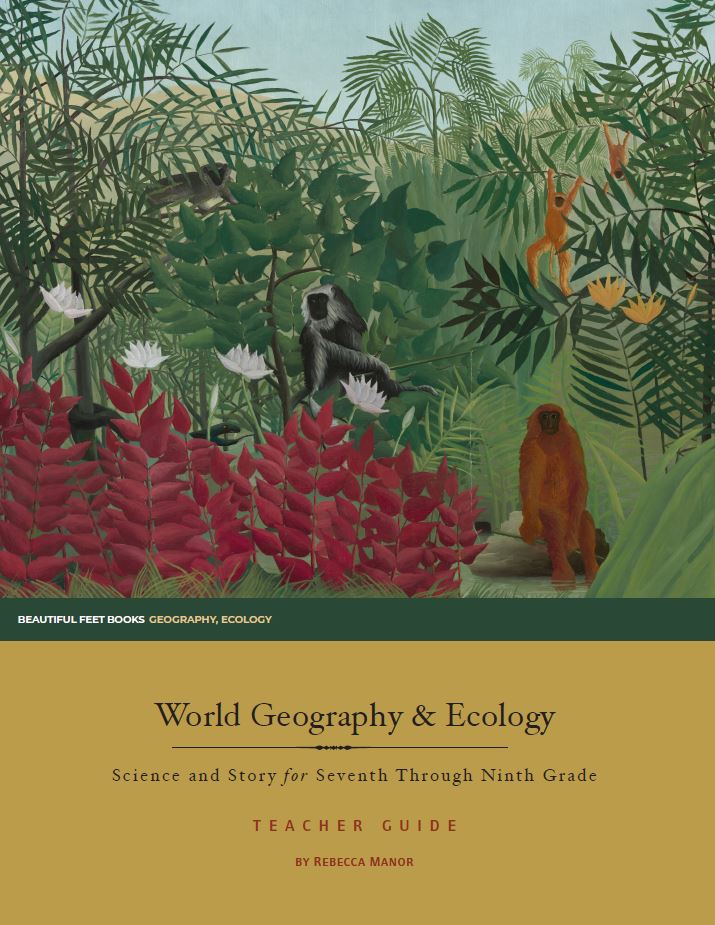World Geography & Ecology: Science and Story for Seventh Through Ninth Grade integrates the study of geography and ecology in a manner that makes the subjects meaningful and interesting to students. As the course introduction explains, “Geography explains the structures of the world around us, while ecology explains the systems that support life in those places.” This new study from Beautiful Feet Books differs somewhat from their many literature-based courses since literature plays a secondary role to other books, online videos, mapwork, and many hands-on activities.
The course covers some science, but I would describe it as a cultural geography course. It can be completed in one year or spread out over two. Either way, the entire course should be worth one high school credit or serve as a one-year course for junior high.
This course is taught from the World Geography & Ecology Teacher Guide, a beautiful, full-color book. The course has eight sections with a total of 98 lessons. The first section focuses specifically on ecology while the other seven sections investigate each continent while continuing to explore ecology. All sections integrate a variety of learning activities in a unit-study fashion.
Seventeen books and a map are required for the course, and there are other optional books. You will want to own the three books that are used throughout the course: DK Student Atlas, The Wondrous Workings of Planet Earth: Understanding Our World and Its Ecosystems, and Junk Drawer Ecology. Fourteen other books are used to put a human face on what students are learning. Most of them are novels about a person who lived in a particular country or through actual historical events, such as The Boy Who Harnessed the Wind about a boy in a drought-stricken village in Malawi who figures out how to build a windmill to generate electric power. Some are biographies, such as Wildheart: The Daring Adventures of John Muir. One book, The Tapir Scientist: Saving South America’s Largest Mammal, is a nonfiction picture book about a tapir-finding expedition. Since each of these books is used over a few weeks, you might borrow them from your library. The blank world map, published by Beautiful Feet Books, will be labeled and colored as students study various countries. (Beautiful Feet Books sells a package with the map and all the required books.)
Other books are recommended, but optional. Among them is Beautiful Feet Books’ 310-page Book of Nations which has a page or two of information and illustrations for each of the world’s 196 countries. The lesson plans direct students to topics in that book under “Supplement” at the end of many lessons. Additional novels and biographies are suggested in case students want to learn more about life in a particular country.
The course also has a downloadable resource packet with visual aids, maps, lists of supplies for the activities for almost every lesson, links to videos and other online resources, and the six recipes that also appear at the end of most “continent” chapters.
Most hands-on activities are from Junk Drawer Ecology, but some are from online sources. Activities generally use household items and school supplies with just a few exceptions. Some activities will take more than one session to complete. For instance, students begin to build a large-scale diorama in Lesson 48 and work on it for a week or two. Some activities are scientific, such as observing an ecosystem up close by building a terrarium. Others involve more arts and crafts, such as making a “Paper Plate Biome” representing the Himalayan Mountains.
Lessons often include links to videos tied to the geography, ecology, or literature students are reading. For example, when students learn about Asia, one of the novels, The Night Diary, tells the story of a family affected by the division of India into two countries (India and Pakistan) in the 1940s. A recommended video on the TED-Ed YouTube channel is titled “Why was India split into two countries?”
The course also includes links to Seterra for geography maps and games.
The introduction to the course says that students need a notebook or portfolio for their work. This might be a binder, a notebook, or computer files. Students will write definitions for keywords, creating their own glossary. They are frequently instructed to “read about” or “learn about” specific topics, but the guide does not specify whether they are to write about what they have learned. (Occasionally, it does tell students to discuss a topic.) It seems to me that writing about what they have learned or researched should be an essential part of the course, but parents will have to determine how much writing to require.
There are just a few questions scattered throughout the guide for students to answer, and a one-page answer key is found toward the back of the guide. The guide says that parents can best judge how well a student is learning the information by their questions, participation in discussions, their interest in topics, and their eagerness to learn more.
Some of the resources used for the course (both print and online) address evolution and climate change in ways that might differ from what parents believe. The course author, Rebecca Manor, provides suggestions for handling such issues on page 5 of the guide along with websites where parents can find more information about these controversial topics. This information mentions God and lists links to websites that present religious beliefs. A few pages further, the guide mentions two series of biographies about Christian heroes. Those who don’t care about these things can easily skip this information.
Summary
World Geography & Ecology offers older students an engaging way to learn geography through a nicely balanced mixture of information, activities, videos, and stories.










